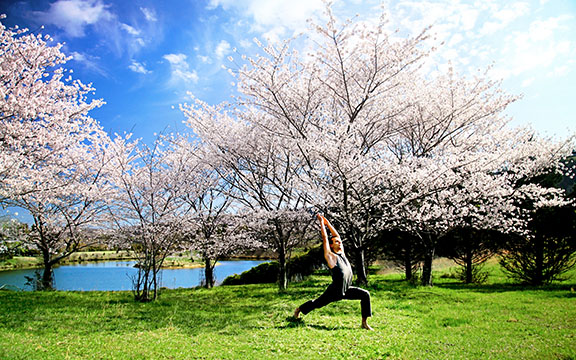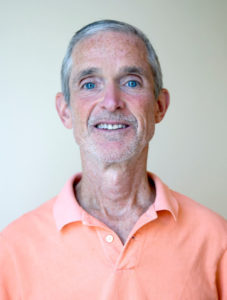 We tend to identify with the body-mind because it is concrete, easily experienced and appears to be permanent, thus dependable, giving us a sense of security and control. Yoga teaches us that we are much more and that to center our lives around body-mind will be ultimately unfulfilling, often painful, leave us feeling incomplete and unhappy, missing love and peace. Hatha Yoga works with the body-mind to lead us beyond this identification to experience the Self, by attuning ourselves step by step to the more subtle aspects of our being.
We tend to identify with the body-mind because it is concrete, easily experienced and appears to be permanent, thus dependable, giving us a sense of security and control. Yoga teaches us that we are much more and that to center our lives around body-mind will be ultimately unfulfilling, often painful, leave us feeling incomplete and unhappy, missing love and peace. Hatha Yoga works with the body-mind to lead us beyond this identification to experience the Self, by attuning ourselves step by step to the more subtle aspects of our being.
Deepak Chopra describes the body’s impermanence by reminding us that “We replace 98 percent of our atoms in one year.” Like a river, we appear to be—but never are—the same. Otherwise, how would neck pain, ulcers, or allergies remain? In exploration of that mystery, ancient yogis discovered the underlying force that animates and structures the body. That force is called prana. The flow of prana gives life to every atom and the patterns of this flow determine physical form—if the flow of prana remains unchanged, so does the form it creates. Those yogis then traced this pattern of prana to its source: the mind. The thoughts and feelings that predominate in the mental level determine the flow of prana that structures the body.
Present day examples of that pattern are easy to find. Medical studies show that people who express a lot of hostility and anger outwardly, have a higher rate of heart disease. People who tend to chronically repress anger have a higher rate of cancer. Dr. Dean Ornish’s book Survival and Healing documents the connection between loving relationships and healing.
Our understanding of how the mind works, while more scientifically accountable, supports those ancient yogic theories. It is estimated that 95 percent of our thoughts are the same as what we’ve had before. Thus, set ways of perceiving ourselves, the world, and reacting to each other, lead to characteristics which develop into habits then into a lifestyle that determines our destiny. What remains truly profound, and even crucial in our quick-paced world, are the ways in which Yoga teaches us to use that information. The rich tradition of Yoga provides specific tools to observe, utilize, and overcome those patterns to assure “an easeful body, a peaceful mind, and a useful life,” as Swami Satchidananda often explained.
In Hatha practice, we attempt to move and think about our movements in ways outside of our patterned thinking and moving. We practice being and acting free of our conditioning by moving with complete, non-judgmental awareness and in loving response to the capacity of the body in this moment only. A mind that is focused, quiet and open can truly listen to the body as it is without interjecting what it should be. It is this accepting awareness that liberates us from egoism and allows the mind to begin to be guided by the deepest part of our being, the Self or spiritual consciousness. Thus we use the body-mind to become less identified with it, and ultimately free of its patterning or conditioning.
Then our mental level can begin to be influenced by the wisdom and compassion of our essence-nature. As our thoughts become healthier, the pranic level also will change, flow more fully, and manifest as healing for the harm caused by unhealthy habits of the past. In this way, our Hatha practice becomes a means to contact the spiritual level and allow its light and energy to express through all the grosser levels of our being, recreating this body-mind in the image of our divinity.
With a conditioned body-mind, it is difficult to rise above our patterned behaviors and thinking, our long time identity, our ways of defining ourselves. Our Hatha Yoga practice very consciously trains us to look and listen deeply within ourselves and to begin to align the body-mind with that consciousness. This process comes over time, with steady effort, patience and non-attachment. With even a little effort to practice Hatha Yoga regularly, you will begin to experience your natural compassion and wisdom. That little effort will be felt in big ways when these qualities spill over into your daily life.
About the Author:
 Swami Ramananda is the president of the Integral Yoga Institute of San Francisco and a greatly respected master teacher in the Integral Yoga tradition, who has been practicing Yoga for more than 35 years. He offers practical methods for integrating the timeless teachings and practices of Yoga into daily life. He leads beginner, intermediate, and advanced-level Yoga Teacher Training programs in San Francisco and a variety of programs in many locations in the United States, Europe, and South America. Swami Ramananda trains Yoga teachers to carry Yoga into corporate, hospital, and medical settings and has taught mind/body wellness programs in many places. He is a founding board member of the Yoga Alliance, a national registry that supports and promotes Yoga teachers as professionals.
Swami Ramananda is the president of the Integral Yoga Institute of San Francisco and a greatly respected master teacher in the Integral Yoga tradition, who has been practicing Yoga for more than 35 years. He offers practical methods for integrating the timeless teachings and practices of Yoga into daily life. He leads beginner, intermediate, and advanced-level Yoga Teacher Training programs in San Francisco and a variety of programs in many locations in the United States, Europe, and South America. Swami Ramananda trains Yoga teachers to carry Yoga into corporate, hospital, and medical settings and has taught mind/body wellness programs in many places. He is a founding board member of the Yoga Alliance, a national registry that supports and promotes Yoga teachers as professionals.

